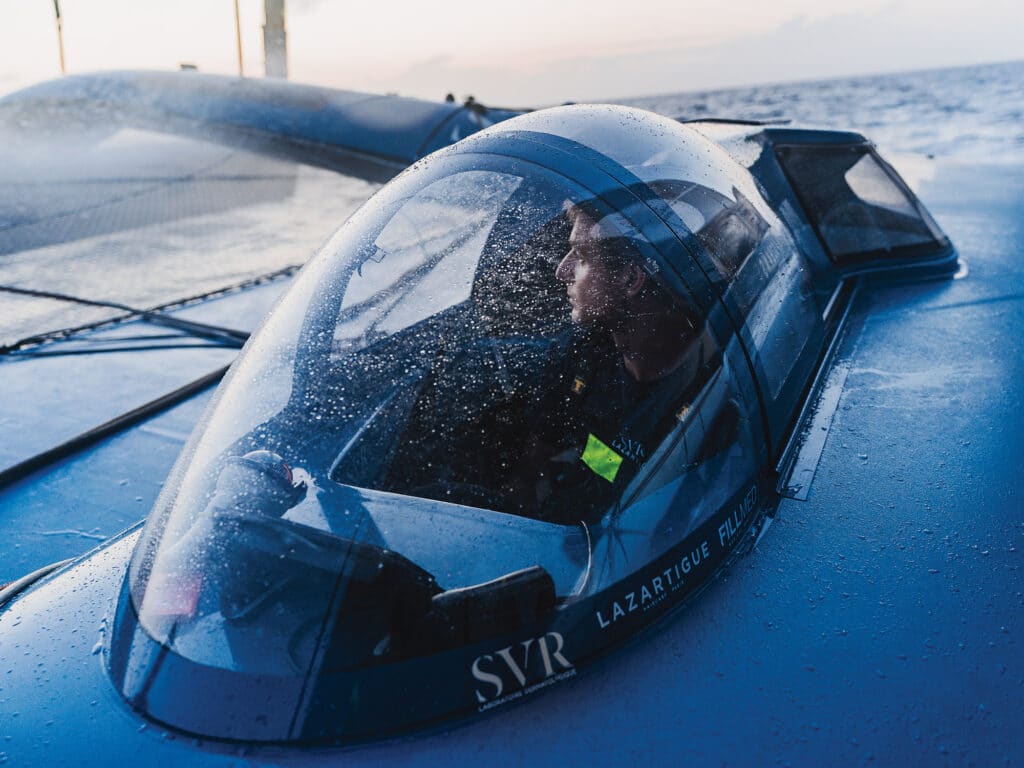
On January 7, ocean racing will take another evolutionary step with the mind-boggling feat of six brave Frenchmen who will set off from Brest in northwest France on board their giant 105-by-75-foot foiling trimarans—around the world, nonstop. Singlehanded. The new event is the Arkea Ultim Challenge-Brest, a sprint marathon that is expected to take 45 days or less at an average of 20 knots.
The present record for a solo lap of the planet stands at 42 days, 16 hours, 40 minutes, 35 seconds, but when this was set in 2018, skipper François Gabart had the luxury of departing with an optimal 10-day forecast (covering the first quarter of his voyage all the way down to the Southern Ocean). Competitors in the Arkea Ultim Challenge-Brest will have to leave on the designated start date and make the best of whatever Mother Nature offers them. However, while Gabart’s MACIF trimaran is going again (in new livery as Anthony Marchand’s Actual Ultim 3), it is now one of the older of the six trimarans that will set out. The newest Ultims, which harness the latest offshore foiling technology, are much, much faster.
Two of the biggest names in solo round-the-world record-breaking will be missing from the lineup; Gabart has passed over the helm of his Ultim to “the next generation” in Tom Laperche. Francis Joyon, who demolished the record for the solo lap on two occasions, bringing it down from 125 days to 72 days in 2005 and from 71 days to 57 days four years later, is now 67. While all six starting skippers are highly experienced, they range in age from 55-year-old Thomas Coville, skipper of Sodebo Ultim 3, to 26-year-old Laperche.
Coville is the race titan. When it comes to racing large trimarans around the world singlehanded, his experience is unprecedented. He’s been attempting circumnavigation records on large trimarans since 1997 and as a skipper since 2008. On his fifth attempt in 2016, he finally set a new record only for it to be broken a year later by Gabart. He also has raced in the America’s Cup and the Volvo Ocean Race (winning it with Franck Cammas on Groupama in 2011-12) and was twice part of crews claiming the Jules Verne Trophy (fully crewed, nonstop around-the-world record). He has completed circumnavigations eight times—four times solo and six times on trimarans.
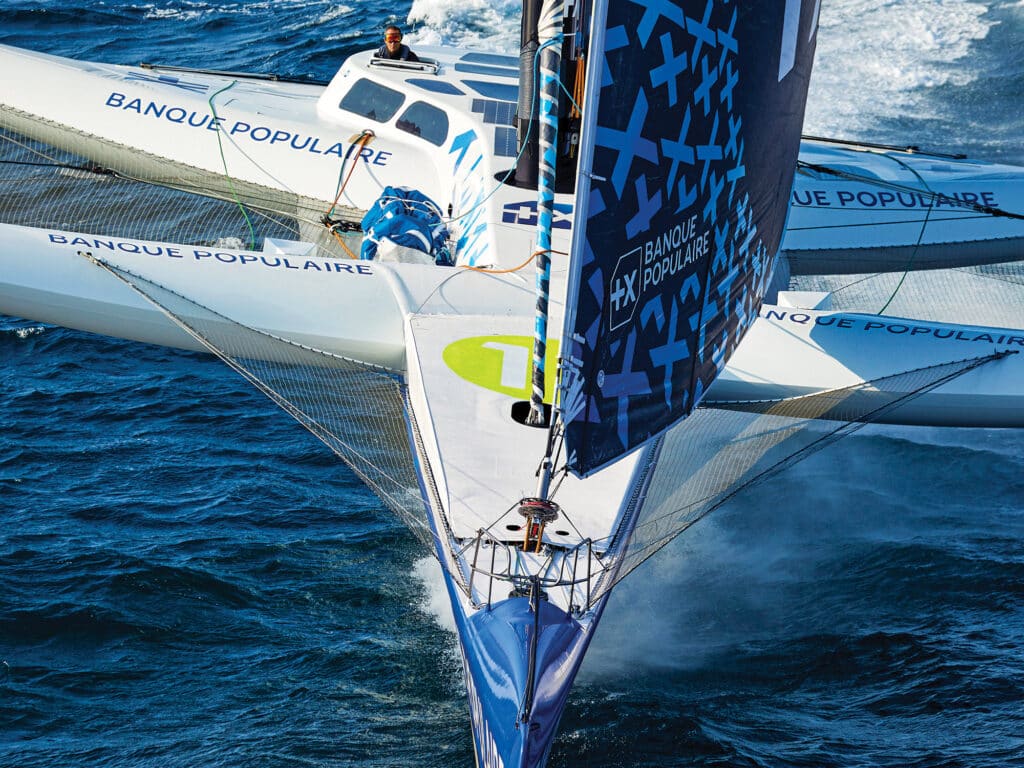
The most hotly tipped skippers, however, are Armel le Cléac’h, 46, on Maxi Banque Populaire XI, and Charles Caudrelier, 49, on Maxi Edmond de Rothschild. While Caudrelier is best known for being a two-time Volvo Ocean Race winner (with Groupama, then as skipper of Dongfeng Race Team in 2017-18), both cut their teeth solo racing in the French one-design Figaro circuit. But when it comes to solo offshore credentials, Le Cléac’h knocks it out of the park. He’s won La Solitaire three times, most recently in 2020, and crucially for the upcoming Arkea Ultim Challenge-Brest has also raced in three Vendée Globe races, finishing on the podium in all and winning in 2016-17.
Le Cléac’h’s trimaran was launched in 2021 as a replacement for his previous Banque Populaire-backed Ultim, which broke up terminally in the 2018 Route du Rhum. Maxi Edmond de Rothschild is unique in the race for being designed by Guillaume Verdier, while the rest are from VPLP (although in every case, the team itself offers substantial input). While Caudrelier has won most Ultim silverware in recent seasons, including the singlehanded Route du Rhum trans-Atlantic race in 2022, Le Cléac’h ended his run by winning this fall’s Transat Jacques Vabre race between Le Havre in northern France and the French Caribbean island of Martinique.
Tom Laperche has taken over as skipper of Francois Gabart’s SVR-Lazartigue for solo races. This is Gabart’s second Ultim trimaran and is considered the most advanced of the six. Laperche won La Solitaire du Figaro in 2022 and has raced with Gabart on the Ultim ever since the boat was launched. He gained his round-the-world experience on the IMOCA Holcim in The Ocean Race.
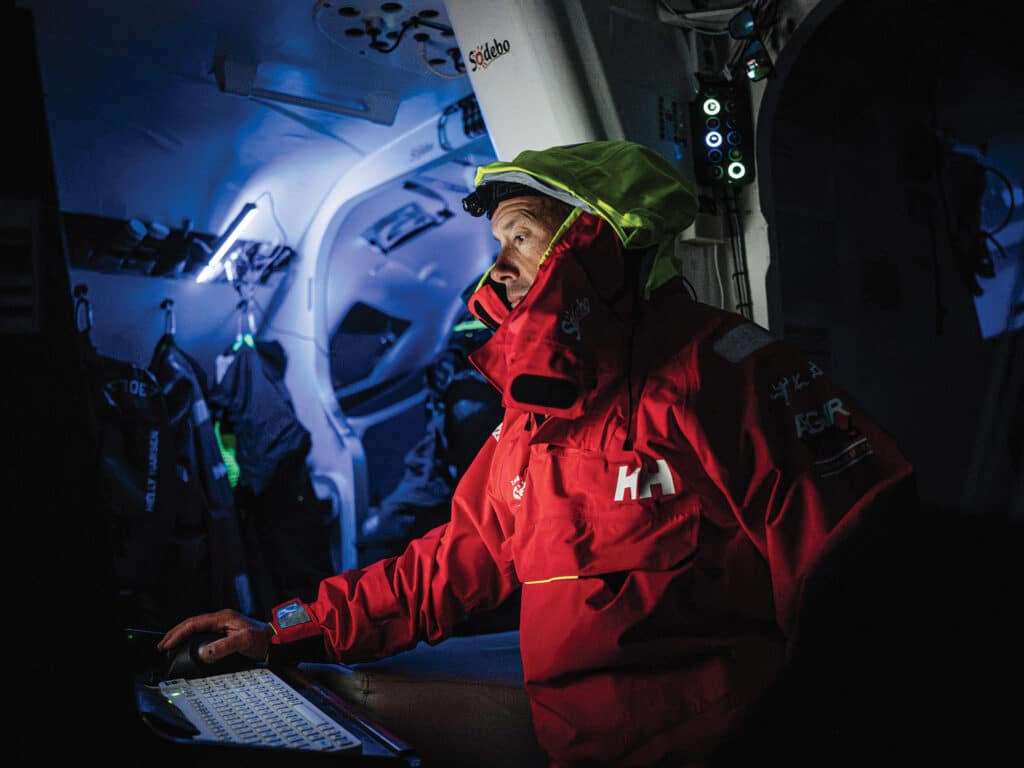
Also inheriting his Ultim campaign is Anthony Marchand, who took over the helm of Actual Ultim 3 from Yves le Blevec in January. Launched in 2015, Actual Ultim 3 is Gabart’s former MACIF trimaran, which is the present holder of the solo round-the-world record. Marchand, 38, sets off with vast experience on ORMA 60 trimarans, in the Figaro class, the Volvo Ocean Race (competing in 2015-16 on MAPFRE) and in the IMOCA.
Fundamentally, the rule limits length to 32 meters and width to 23 meters, and the complex foil configuration on all six Ultims is fairly similar.
Éric Péron, 42, is the race’s last-minute entry, and as a newcomer to the Ultim class, he will likely back marker. Péron has a strong background in the Figaro and Ocean 50 trimaran classes, and his trimaran Adagio was previously Sodebo Ultim, on which Coville set both his solo round-the-world and west-to-east trans-Atlantic records.
While there is an Ultim 32/23 rule, the design parameters of these incredible machines is a work in progress. Fundamentally, the rule limits length to 32 meters and width to 23 meters. The complex foil configuration on all six Ultims is fairly similar. Each of the boats has six appendages, including the giant, retracting rake-adjustable J-foils (of varying shapes) in the floats. The latest-generation foils have grown larger, enabling the trimarans to fly both downwind and upwind in less wind. Among the three front-runners, the most recent edition of the Transat Jacques Vabre demonstrated that SVR-Lazartigue has the lowest take-off speed, while Maxi Banque Populaire XI’s foils work best in waves. Maxi Edmond de Rothschild lies somewhere between these two positions.
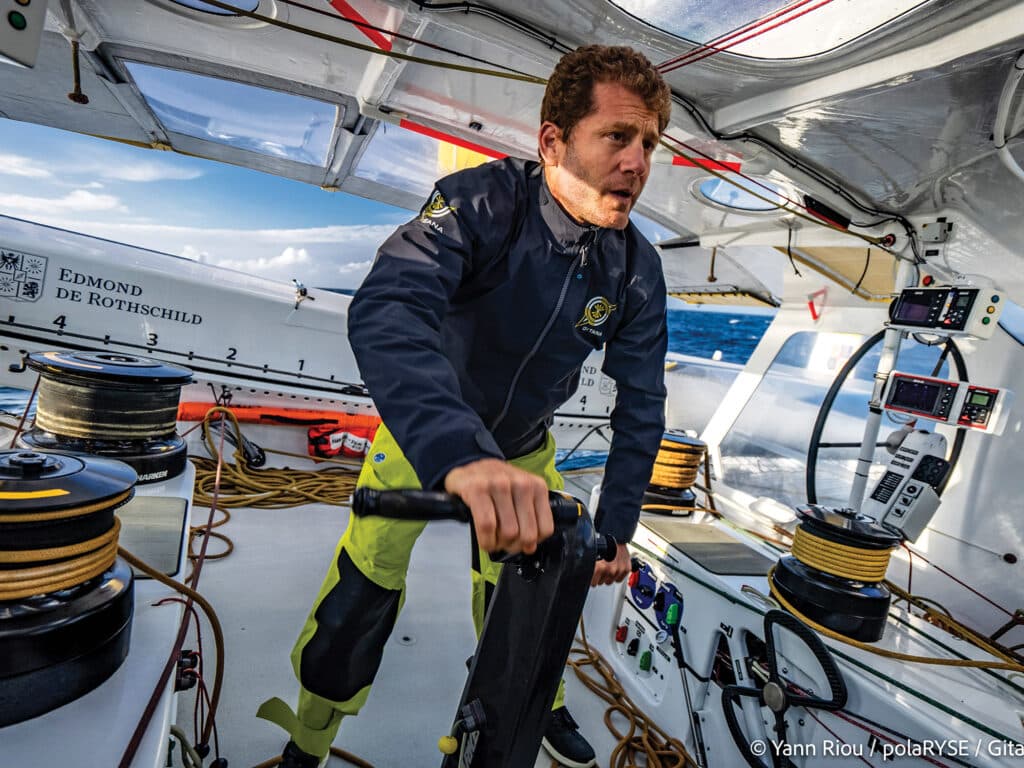
Unique to the Ultims is the T-foil pioneered by Caudrelier’s team on their MOD70 (now Giovanni Soldini’s Maserati). Located in the center hull, this is effectively a daggerboard with a trim tab (to aid pointing ability upwind) and an elevator. This foil is used in a similar fashion to how AC50 catamaran crews negatively raked their windward rudder elevator to produce downforce, sucking the weather hull down. When a gust hits an Ultim, the crew can drop the traveler, but a more energy efficient response is to increase pitch on the T-foil’s elevator to create additional downforce. Then there are three rudders (one on each hull), each with an elevator. The rudders in the floats can be raised (typically the windward one) to reduce drag.
Aside from the significant developments to the foils, especially to reduce cavitation at high speed, teams have been focusing on improving aerodynamic efficiency. The Ultims now have low-drag vinyl fairings for the aft side of their crossbeams, and on some boats, the deck itself forms an endplate for the foot of sails. Living quarters have improved dramatically and, like modern IMOCAs, are becoming increasingly enclosed. The most extreme among them is Sodebo Ultim 3, where the front of Coville’s “bridge” is forward of the mast step.
Autopilots have transcended beyond being able to steer to course, apparent wind angle or even true wind angle. Depending on the point of sail, the pilot will now automatically head up or bear away when a gust hits.
The rigs are the same as those that have been fitted to French multihulls for the past 30 years—a rotating wing mast with each shroud terminating in a giant hydraulic ram, permitting the rig (and its center of effort) to be canted to weather. This reduces the downward force on the leeward bow, which can cause multihulls to pitchpole. Whether this is still required is a moot point because today’s foils effectively keep the leeward bow from immersing.
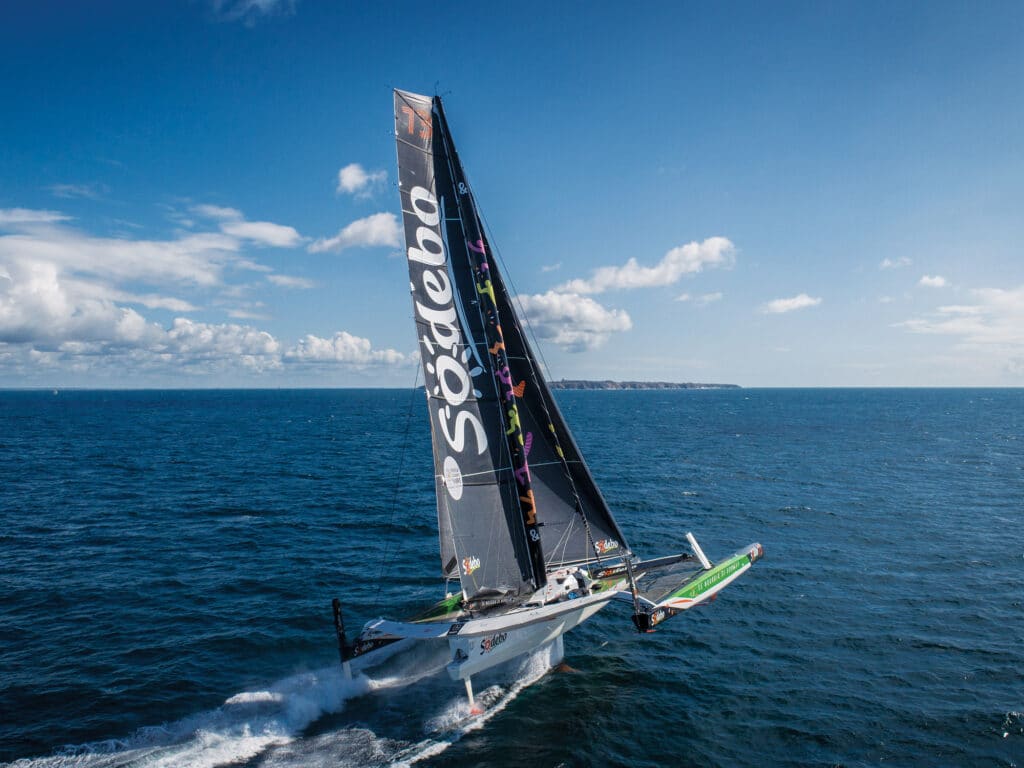
Due to the sheer physics of an Ultim, aided by the canting rig and the mast being stepped so far aft, the risk of capsize is almost nonexistent, Caudrelier says: “The Ultims are the safest multihulls because they fly, because they are big, but also because we have made huge improvements to the pilots with safety functions, and also we have a nice automatic system to ease the sails. It is quite safe. I don’t worry too much about capsizing, but I have in the back of my mind that it can happen.”
Thanks to teams working with such companies as B&G and Pixel sur Mer, Ultim autopilots have transcended beyond being able to steer to course, apparent wind angle or even true wind angle. Depending on the point of sail, the pilot (using what’s referred to as its “safety overlay”) will now automatically head up or bear away when a gust hits, which it can detect by the wind instruments or an inclinometer. In extreme circumstances, they have systems to dump the sheets, although these too seem to be near-redundant.
An interesting point of dispute between the Ultim teams is how much automation should be permitted. Caudrelier’s team is pro automation, while other teams are less so. As a result, the autopilot can perform these functions but cannot, for example, adjust the boat’s flying mechanism, to automatically set ride height, pitch, etc.
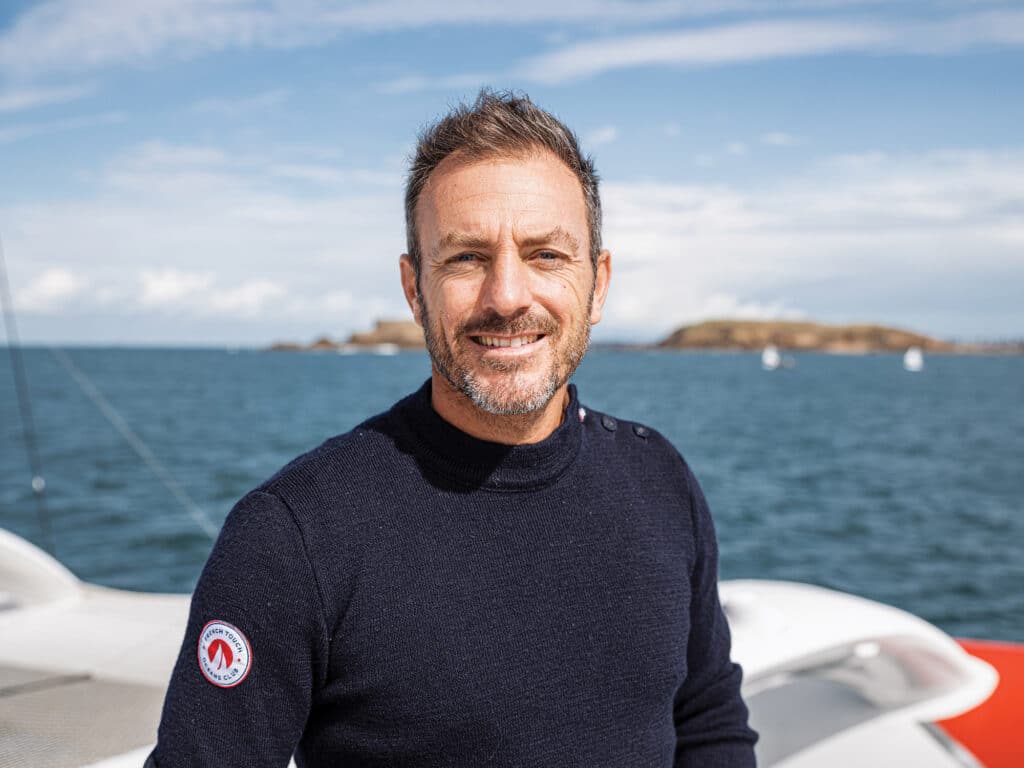
If capsize is less of a concern, then the skipper’s biggest worries are technical failures on their giant boats, as well as collisions. They have tried to overcome the former through sheer time at sea, testing and failing to improve reliability. Le Cléac’h, for example, says that in the past year, he has sailed Maxi Banque Populaire XI some 20,000 miles, or half a circumnavigation. This has been solo and crewed, in a mix of races, private sea trials and the Ultim fleet training en masse. To avoid collisions, the Ultims have all available kit from radar to AIS alarms to the latest tech such as SEA.AI, which uses a masthead-mounted camera array to see objects—floating or semisubmerged—in the water ahead of the boat. These are compared in real time with the SEA.AI’s huge and ever-growing database of objects to identify them as threats.
In the recent Transat Jacques Vabre, Maxi Edmond de Rothschild suffered rudder issues soon after the start (later found to be a delaminating starboard rudder) and then damage to its port J-foil, but it still finished the race. It seems, therefore, very likely that this level of attrition can be expected in the Arkea Ultim Challenge-Brest. Caudrelier says that this proved to be a wake-up call for his team as well as valuable practice for how to deal with midrace technical issues. For example, the J-foil damage occurred after a small impact. “But while we were sailing, the damage increased,” he says. Perhaps it would have been faster in the long term to stop, fix the issue, and then continue, he muses. For bigger issues, race’s sailing instructions permit skippers to pitstop where their teams can join them to effect repairs, but in this case, they are obliged to spend a minimum of 24 hours in port as a penalty.
To help reduce risks, OC Sport Pen Duick, the race’s organizers, are imposing a movable virtual ice barrier as we have seen in other round-the-world races. Competitors must stay north of this, regardless of whether it drives them into high pressure or storms. Interestingly, they are also imposing exclusion zones around known breeding grounds for whales (yet to be defined at the time of writing).
The Arkea Ultim Challenge-Brest may be a solo race, but each campaign is genuinely a team affair. Ultim teams today are giant, some the scale of America’s Cup teams two or three decades ago, with their own in-house designers, engineers, hydro and aerodynamic specialists, and electronic and hydraulic experts. In the event of a technical issue during the race, skippers can now get immediate support using reliable satellite communications. The most consistent remote support each skipper gets is with their routing. In the Ultim class, shore-based routing is permitted. Le Cleac’h, for example, is using Dutch legend Marcel van Triest and French skipper/navigator Nicolas Lunven to provide round-the-clock routing assistance.
Ultims are fast—50 knots is very possible—but skippers are less interested in top speed and entirely focused on maintaining high averages of 30 to 35 knots. They don’t need much wind to achieve such a pace, however. An Ultim’s optimal conditions are broad-reaching in 20 to 25 knots. Any more wind than that, and the sea state gets too large to foil safely. Even in optimal wind conditions, skippers must back off if sea state and wave direction is not ideal. Understanding this is vital to the routing process.
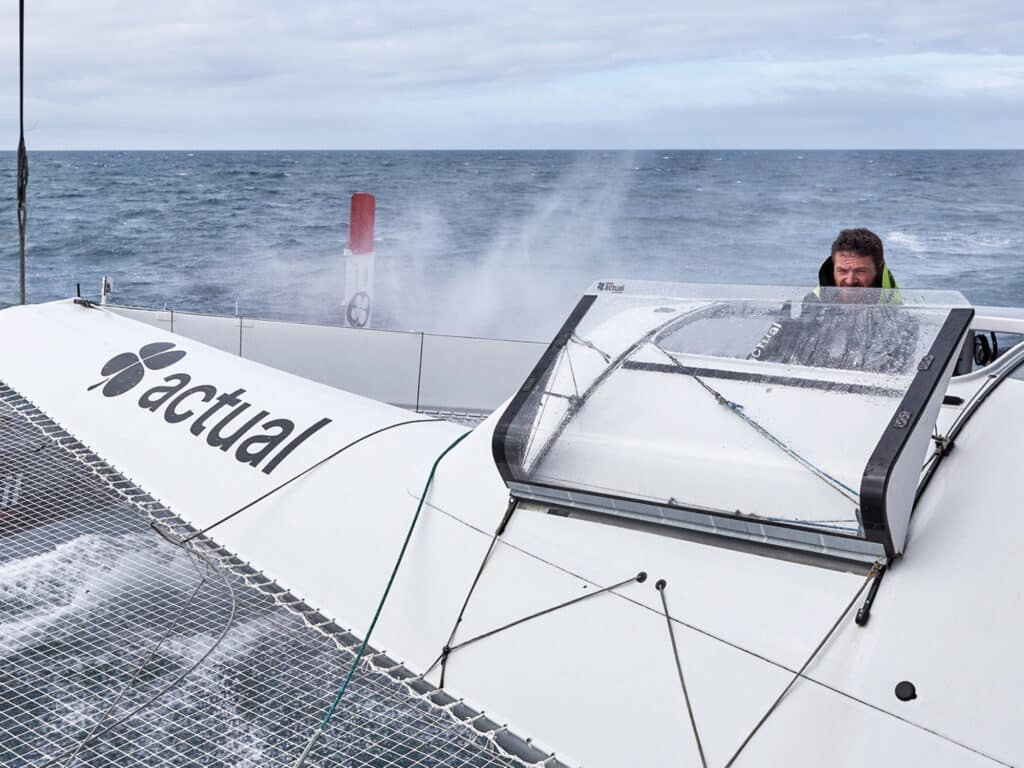
The Ultims are potentially so fast that their routing team can go a long way in ensuring that they stay in optimal conditions. For example, in the Southern Ocean, if they can get into the optimal reaching conditions in flat water ahead of a front, they can potentially ride this for days. But the biggest limitation is the solo skipper. The Ultims typically carry a mainsail and four headsails, including two gennakers and a permanently hoisted J2, all set on furlers. Tacking and jibing requires the sails to be released and sheeted in, the mast to be canted and tacked, and foils and rudders to be raised and lowered. It’s a process that typically takes 20 to 30 minutes. Le Cleac’h says that the most time-consuming sail change is going from the J0 to the J1 because the sails are heavy (around 120 kg), and this can take up to an hour. Factoring all this into the routing is vital because the skipper on his own can do only so much.
“If reaching 95 percent of the boat’s potential requires making three jibes and four tacks and to change two sails, it will be difficult to do that if you are tired,” Le Cleac’h says. His routers offer him three options—from the one offering optimal performance to the easiest for him to achieve—which can be decided based on his energy level and capabilities.
One positive for the skippers is that the required endurance is comparably short compared with a Vendée Globe effort, but still, so much remains unknown as they embark on this extreme test of man and machine.
“It is a bit like the first Vendée Globe,” Caudrelier says. “It is not quite the same because we know where we are going, but it is the first one, so it is a bit of an adventure. Usually you push to the maximum constantly, but for me, this is the first time I can’t do that. We will have to find the good balance between good performance and safety of the boat. That is an interesting exercise.”









